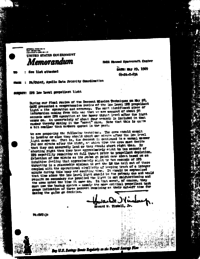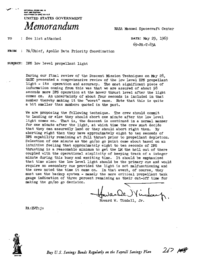See list attachedMay 29, 196969-PA-T-83APA/Chief, Apollo Data Priority CoordinationDPS low level propellant light
During our final review of the Descent Mission Techniques on May 28, GAEC presented a comprehensive review of the low level DPS propellant light – its operation and accuracy. The most significant piece of information coming from this was that we are assured of about 98 seconds more DPS operation at the hover thrust level after the light comes on. An uncertainty of about four seconds is included in that number thereby making it the “worst” case. Note that this is quite a bit smaller than numbers quoted in the past.
We are proposing the following technique. The crew should commit to landing or else they should abort one minute after the low level light comes on. That is, the descent is continued in a normal manner for one minute after the light, at which time the crew must decide that they can assuredly land or they should abort right then. By aborting right then they have approximately eight to ten seconds of DPS capability remaining at full thrust prior to propellant depletion. Selection of one minute as the go/no go point came about based on an intuitive feeling that approximately eight to ten seconds of DPS thrusting is a reasonable minimum to get the LM the hell out of there coupled with the operational simplicity of keeping track of a integer minute during this busy and exciting time. It should be emphasized that time since the low level light should be the primary cue and would require no secondary cue provided the light is not malfunctioning and the crew noted the time it came on. In that event, of course, they must use the backup system – namely the more critical propellant tank gauge indication of three percent remaining as their cut-off time for making the go/no go decision.
- Jul 16, 1968 – LM Descent abortability computation is proposed (6.1σ)
- May 14, 1968 – Aborts from powered descent on the lunar landing mission (4.8σ)
- Nov 25, 1968 – LM DPS low level light fixing (4.2σ)


